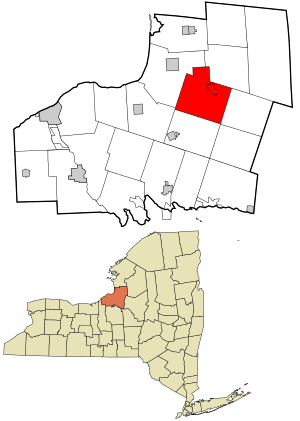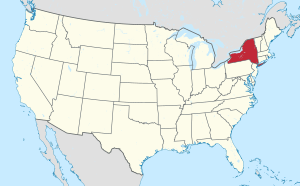Albion, Oswego County, New York facts for kids
Quick facts for kids
Albion
|
|
|---|---|

Location in Oswego County and the state of New York.
|
|

Location of New York in the United States
|
|
| Country | United States |
| State | New York |
| County | Oswego County |
| Incorporated | 1825 |
| Area | |
| • Total | 47.82 sq mi (123.85 km2) |
| • Land | 47.29 sq mi (122.47 km2) |
| • Water | 0.53 sq mi (1.38 km2) |
| Elevation | 561 ft (171 m) |
| Population
(2020)
|
|
| • Total | 2,009 |
| • Density | 46.21/sq mi (17.84/km2) |
| Time zone | UTC-5 (EST) |
| • Summer (DST) | UTC-4 (EDT) |
| ZIP code |
13302
|
| Area code(s) | 315 |
| FIPS code | 36-075-01055 |
| Website | http://www.townofalbion-ny.us/ |
Albion is a town in New York, located in the northeastern part of Oswego County. In 2020, about 2,009 people lived there, according to the 2020 census.
Contents
History of Albion, New York
Early Days and First Settlers
Long ago, before 1788, Native Americans visited this area. They came to hunt and fish for salmon. They called the place Alkineaur, which means "sand bank." On March 1, 1788, this land officially became part of New York State.
In 1791, two brothers, John and Nicholas Roosevelt, bought a large piece of land. Part of this land would later become the town of Albion. They sold it to George Scriba, a man from Holland, in 1792. This land was then known as "Scriba's Patent."
The land was divided starting in January 1795. On March 24, 1804, the Town of Williamstown was created. Later, on February 20, 1807, the Town of Richland was formed. A part of Richland would eventually become Albion.
The first settler arrived in 1812. A fur trader named Cary Burdick bought land near present-day Altmar. In 1813, the Lilly brothers, David, Luther, and Benjamin, settled nearby. They built the first sawmill in the area.
Growth and Development
Peter Henderson, from Scotland, was the first settler in what is now the village of Altmar. He bought 200 acres (0.81 km2) of land by the Salmon River. In 1814, Dr. Brace opened a tavern in the village of Sand Bank. The first schoolhouse in Albion was built in 1816. Sylvia Breed was the first teacher there.
In 1819, the first marriage in the town took place. Moses Rich built the first Grist Mill in Sand Bank in 1822. On March 24, 1825, the Town of Albion was officially separated from the Town of Richland. George Scriba had originally named this area Alkmaar, after a town in his home country.
The first town meeting in Albion was held on May 3, 1825. Local officials were chosen at this meeting. In 1828, Ammi Hinckley opened a general store in Sand Bank. Another tavern, run by William Abbott, was also open around this time.
Churches and Community Life
The First Presbyterian Church was started on January 27, 1829. Services were held in the schoolhouse. This church later became the First Congregational Church. The Union Church was built in Sand Bank in 1834. It was used by both Presbyterians and Methodists.
In 1837, the Albion Baptist Church was formed. The Pineville Methodist-Episcopal Church was also built. Its foundation used stones from the shores of Lake Ontario. In 1856, the Dugway Union Church was organized and a building was put up.
The village of Sand Bank became an official village on February 21, 1876. On October 13, 1885, a big fire destroyed most of the village. Only the Congregational Church and the Episcopal Church, which was still being built, remained in the business area. On February 17, 1895, the Methodist church built a new building. About a month later, on March 18, 1895, Sand Bank was renamed Altmar.
Transportation and Industry
Albion's first post office was set up in the summer of 1837. William Abbott was the first Postmaster. William Worden was the first mail carrier, delivering mail between Oswego, Utica, and Albion.
A building was built in 1852 at Albion Center. This building later became known as Grange Hall and is still standing today. In the 1840s and 1850s, many new settlers came to Albion. This led to a high demand for lumber, which became the main industry. In 1850, a "plank road" was built between Albion and Constantia, which is now Route 13.
In 1851, the R. W. & O. Railroad began building tracks through Albion. The train station in Sand Bank was finished in May 1852. The Chapman brothers built the first of many tanneries in the town. Many Irish immigrants, who were escaping hard times in their home country in the 1840s, found work here. The Sand Bank Cemetery Association was started on March 21, 1853.
Wars and Schools
In the 1860s, 350 men from Albion joined the Union Army and Navy during the American Civil War. Fifty-six of these men died, and many others were injured. On June 14, 1911, a monument honoring Civil War soldiers was revealed in the Riverside Cemetery in Altmar.
In 1918, twenty-two men from Albion served in World War I. Delbert Russel was killed in action on June 15, 1918. On April 24, 1936, a brick school was built in Altmar. It is now called Altmar Elementary School. In the 1940s, twenty men from Albion served in World War II. Edgar Tryon was killed in action on October 4, 1944.
On April 28, 1959, the Altmar-Parish-Williamstown School District built a new high school in Parish. It opened in the fall of 1960. In 1979, the Salmon River Fish Hatchery began construction in Altmar. In 1989, the Altmar-Parish-Williamstown School District built a new middle school.
Geography of Albion
Albion covers a total area of about 47.8 square miles (123.8 km2). Most of this area, about 47.2 square miles (122.2 km2), is land. The remaining 0.6 square miles (1.6 km2), or about 1.17%, is water.
Population and People
| Historical population | |||
|---|---|---|---|
| Census | Pop. | %± | |
| 2020 | 2,009 | — | |
| U.S. Decennial Census | |||
As of the census in 2000, there were 2,083 people living in Albion. These people made up 704 households, with 539 of them being families. The population density was about 44.1 people per square mile (17.0/km2).
Most of the people in Albion were White (98.42%). A small percentage were African American, Native American, Asian, or from other backgrounds. About 0.62% of the population was Hispanic or Latino.
About 38.4% of households had children under 18 living with them. Most households (61.4%) were married couples living together. The average household had 2.95 people, and the average family had 3.25 people.
The median age in Albion was 33 years old. About 31.2% of the population was under 18. The median income for a household in the town was $38,083. For a family, the median income was $40,000.
Communities and Locations in Albion
- Albion Center – A small village southwest of Altmar.
- Altmar – A village located on State Route 13 and the Salmon River.
- Barber Corners – A place north of Albion Center.
- Centerville – A village in the northwestern part of the town, north of Pineville.
- Dugway – A village on State Route 104, west of Howardville.
- Howardville – A village on State Route 104 in the southern part of the town.
- Maple Corners – A location at the western edge of the town.
- Mosher Corners – A village in the southern part of the town.
- Pineville – A village on the Salmon River, northwest of Altmar on State Route 13.
See also
 In Spanish: Albion (condado de Oswego, Nueva York) para niños
In Spanish: Albion (condado de Oswego, Nueva York) para niños

